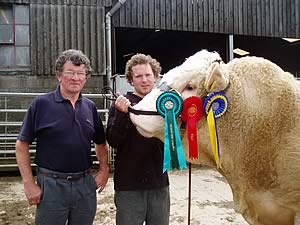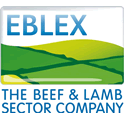2009-07-31
The Sowenna herd owned by Keith and Caroline Hawkey and their son Piers, who farm near Bodmin, Cornwall, has been recognised by EBLEX as the Most Improved Herd of the British Simmental breed for 2008/09.
Keith Hawkey and his son Piers with their award winning
Simmental Bull, Sowenna Tamar
 |
The award is presented by the EBLEX Beef Better Returns Programme (Beef BRP), to the recorded herd that shows the greatest genetic gain for commercial traits over a 12-month period. There is a separate award for each of ten UK breeds.
Tregolls has been farmed by the Hawkey family for three generations. Twelve years ago the farm was split amongst three brothers, with Keith taking on the upland area of 50ha (200 acres) of permanent grassland, creating Higher Tregolls.
The Sowenna herd comprises 35 pedigree cows and ten heifers and was established five years ago with the purchase of six breeding females.
“We have had Jason, a pedigree Simmental bull, for the past nine years to serve the commercial cattle,” explains Mr Hawkey. “He has been a terrific bull, and is one of the main reasons we decided to upgrade to pedigree Simmental. The calves tend to be quiet and are easy to manage. Although they can seem small at calving, they do have terrific growth rates.”
The cows calve over ten weeks from mid-April in paddocks close to the house before being moved up onto fresh grazing. The calves have access to ad-lib creep feed in the field. They are brought indoors in mid-November and left with their dams for three weeks to become familiar with the sheds. At seven to eight months, they are weaned and the bull and heifer calves are separated.
The bulls are kept on straw and finished at around 14 months on an ad-lib
14% crude protein compound feed. Heifers are fed silage and compound feed in the winter, turned out in the spring and spend the summer outside. Those not kept for breeding are finished during the following winter.
When deciding which females to keep for breeding, Mr Hawkey says they have to be pleasing to the eye – but more importantly they must have good Estimated Breeding Values (EBVs) for key traits such as growth rate and ease of calving.
As well as Jason, AI has been used to introduce new bloodlines and the Hawkeys have bred their own bull, Sowenna Tamar. He is now three years old and is producing consistent, well-muscled progeny. Three bulls, all sons of Tamar, took the top three places out of 12 candidates at the Royal Cornwall Show 2009. Tamar was also awarded first prize in the Senior Bull class.
Commenting on winning the BRP award, Mr Hawkey said he was absolutely delighted.
“The overall appearance of the herd has changed significantly over the past few years, and we are definitely experiencing easier calvings with only one assisted birth this year,” he says.
“We have also noticed markedly improved growth rates and are now finishing most of the bulls by 13 months of age. Quick finishing is the key to efficient beef production.
“Tools such as EBVs have helped us focus and select for the really important traits. We now have our eye on a couple of other high EBV bulls who we would like to try, as we think they can take us forward even further.”
EBLEX breeding specialist Samuel Boon agrees:
“EBVs are measurements of genetic potential and provide a reliable insight into the effect a bull could have on the herd,” he says. “It means producers can make informed purchasing decisions rather than leaving it to chance and hoping the chosen bull will deliver on the commercially important traits.
“All the winners of the Improved Herd Awards record the performance of their herds. All are providing valuable information that can help customers produce animals that make them money because they meet processor/retailer and consumer demand, and do so as efficiently as possible.
“I congratulate the Hawkeys on the excellent job they are doing with the Sowenna herd.”
 Pia Troon Herd Wins EBLEX Award for British Charolais Breed Pia Troon Herd Wins EBLEX Award for British Charolais Breed
 All Ireland Aberdeen Angus Championships at Clogher Valley Show All Ireland Aberdeen Angus Championships at Clogher Valley Show
 Druk Herd Wins EBLEX Award for British Blonde Breed Druk Herd Wins EBLEX Award for British Blonde Breed
|



